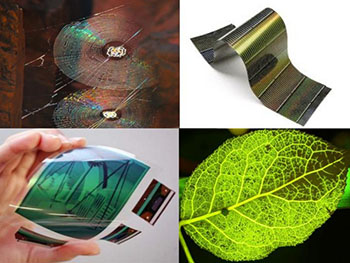
An international team looked at networks such as spider webs and leaf veins as models for new optoelectronic networks for use in solar cells and flexible displays. [Image: Boston College]
Scientists from China and the United States have proposed the use of two “natural scaffoldings perfected by evolution”—leaf networks and spider’s webs—as models for micro-scaffold networks to drive optoelectronic applications (Nat. Commun., doi: 10.1038/ncomms6674). Prototype networks built on these principles, according to the team, achieved a fourfold increase in electro-optical properties, with significant improvements in mechanical properties, relative to alternative materials. The researchers believe that the technique could have wide use in applications ranging from solar cells to flexible displays.
The work’s motivation stemmed from a long-standing problem in developing optoelectronic materials: the desired goals of high optical transmission and good electrical conductivity often work against one another, since electrical carriers tend to scatter photons. While some materials, such as indium-tin oxide, have been developed that get around this paradox, their brittle mechanical properties limit their use in many applications. And approaches based on more flexible, man-made nanowire grids and atom-scale scaffolds, while better mechanically, have thus far sported insufficient electro-optical performance.
The team from South China Normal University, Boston College (USA) and the University of Houston (USA) looked at a different approach for these materials: networks derived from natural systems, where natural selection had worked to resolve analogous problems.
The team’s work focused on two specific natural models. The first example—suggested for applications such as window electrodes for solar cells, light sources and transparent heaters—involved metallization of the quasi-fractal microfluidic network structure present in the leaf veins of the white jade orchid tree, Magnolia alba. These structures have been tuned by evolution for efficient nutrient delivery, light harvesting and strength; hence, the team reasoned, their adaptation, in a metalized form, might translate into efficient current transport and good optical and mechanical properties.
The second network built by the team was a metalized version of the silk web of a common spider, Agelena labyrinthica. Here, the salient feature was the web’s fundamentally two-dimensional structure and its mechanical strength and flexibility, for which the scientists saw immediate use in applications such as flexible displays.
Both of the experimental networks showed transmittance and conductivity values well above most other recently proposed, man-made micro- and nano-scaffold schemes, according to the researchers. And the spider-web-inspired design also performed well in mechanical tests: the metalized web could be stretched up to 25 percent with no loss of performance and up to 100 percent with only a small performance decline. “No other electrode network can be stretched more than 10 percent,” said Krzysztof Kempa of Boston College, a member of the team.
Kempa’s colleague and coauthor, Andrzej Herczynski, notes that the work’s basic idea is “quite simple and far-reaching. It starts with the premise that natural forms offer ready-made solutions for efficient designs, tested over millions of years through natural selection.”
